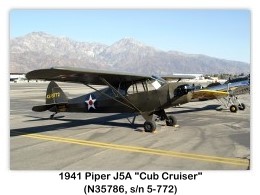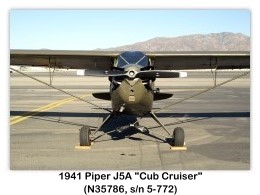

























Piper J-5A Cub Cruiser
Single-engine two-seat high-wing propeller-driven light cabin monoplane
Archive Photos 1
1941 Piper J-5A Cub Cruiser (N35786, s/n 5-772) on display at the 2006 Cable Air Show, Cable Airport, Upland, California (1/7/2006 John Shupek photo copyright ©2006 Skytamer Images)



Overview 2
Piper J-5 Cub Cruiser
- Role: Multipurpose light civil aircraft
- Manufacturer: Piper Aircraft
- First flight: July 1939
- Produced: 1940-1946
- Number built: 1,507
- Unit cost: US$1,995 (1947)
- Variants: Piper J-3, Piper PA-12
The Piper J-5 Cub Cruiser was a larger, more powerful version of the basic Piper J-3 Cub. It was designed just two years after the J-3 Cub, and differed by having a wider fuselage with the pilot sitting in the front seat and two passengers sitting in the rear seat. Equipped with a 75-hp Continental engine the plane’s cruising speed was 75 mph. Though officially a three-seater, it would be more accurately described as a "two-and-a-half-seater", as two adults would find themselves quite cramped in wider rear seat. The Cruiser sold for $1,995 when it was first designed.
Production of the three models of the J- (-A, -B, -C), fall into two categories that differ considerably. The obvious difference can be seen in the landing gear. Early versions, of which 783 were built between 1940 and early 1942, have external bungee’s. Those built from 1944 to 1946 included design changes developed for the United States Navy HE-1 flying ambulance, and these models have internal bungees. Currently over 500 J-5s remain on the FAA registry.
History 2
Throughout World War II, Piper modified the basic structure of the J-5A. The J-5B had a 75-hp Lycoming GO-145-C2 engine. The later J-5C also built as the HE-1 (later AE-1) ambulance for the U.S. Navy with rear hinged fuselage decking, used the fully cowled 100-hp Lycoming O-235-C engine with an electrical system, and redesigned landing gear.
After the war, Piper dropped the J- designation system in exchange for the PA- system, and the J-5C became the PA-12 Super Cruiser. The Super Cruiser was more popular than the basic J-5A, with 3,759 being built.
Piper also produced a four-seat variant of the Super Cruiser with a 115-hp engine. It was designated the PA-14 Family Cruiser. It was the least successful of the three Cruiser designs in terms of aircraft sold, with 238 being built in 1948/49, and only about one hundred remain in existence.
Variants 2
- J-5: 75-hp Continental A-75-8 powered variant.
- J-5A: Continental A-75-9 powered variant.
- J-5A-80: J-5As modified with a 80-hp Continental A-80-8 engine.
- J-5B: 75-hp Lycoming O-145-B powered variant.
- J-5C: 100-hp Lycoming O-235-C powered variant.
- J-5CA: Prototype ambulance variant produced as the HE-1 for the United States Navy.
- J-5CO: Prototype observation variant, later modified as the L-4X to be a prototype for the military L-14 version.
- J-5D: 1946 built aircraft with a 125-hp Lycoming engine.
- YL-14: Prototype liaison aircraft for the United States Army Air Force, five built.
- L-14: Production variant of the YL-14, order for 845 canceled and nine under construction completed for the civilian market.
- AE-1: HE-1 redesignated in 1943 in the Ambulance category.
- HE-1: Hospital variant for the United States Navy with hinged fuselage top for stretcher access, 100 built later re-designated AE-1.
- UC-83: Four J-5A aircraft impressed into military service in Panama later becoming the L-4F.
- L-4F: Four UC-83s re-designated and an additional 39 J-5As impressed.
- L-4G: J-5B impressed into military service, 34 aircraft.
Specifications (J-5A) 3
Type
- Three-seat light cabin Monoplane.
Wings
- High-wing braced monoplane.
- Wings attached direct to built-in center-section on top of the fuselage and braced to the lower longerons by steel-tube Vee struts.
- Wing structure consists of spruce spars and aluminum-alloy ribs, the whole being covered with fabric.
- Frise-type ailerons operated by cables.
Fuselage
- Rectangular structure of welded steel tubes, with fabric covering.
Tail Unit
- Braced monoplane type.
- Welded steel-tube framework covered with fabric.
- Self-aligning streamline wire bracing.
- Elevator tab adjustable in flight.
Undercarriage
- Divided type.
- Consists of two side fees and two half-axles hinged to cabane below fuselage.
- Rubber-chord springing at top anchorages of axles.
- Wheel landing-gear may be replaced by twin Edo all-metal floats.
Power Plant
- One 75 hp Continental A-75-8 four-cylinder horizontally-opposed air cooled engine.
- Fuel tank (18 US gallons) in fuselage.
- Also available with the 75 hp Lycoming geared engine.
Accommodation
- Enclosed cabin with single-seat forward and side-by side seats behind.
- Dual controls.
Dimensions
- Wing span: 35 ft 5½ in (10.8 m)
- Length: 22 ft 6 in (6.9 m)
- Height: 6 ft 10 in (2.1 m)
Areas
- Wing area: 179 ft² (16.6 m²)
Weights
- Weight empty: 760 lb (345 kg)
- Payload: 380 lb (172 kg)
- Disposable load: 690 lb (313 kg)
- Weight loaded: 1,450 lbs (658 kg)
Loadings
- Wing loading: 8.1 lb/ft² (39.5 kg/m²)
- Power loading: 18 lb/hp (8.8 kg/hp)
Performance
- Maximum speed: 95 mph (153 km/h)
- Cruising speed: 85 mph (136.8 km/h)
- Landing speed: 40 mph (64 km/h)
- Initial rate of climb: 450 ft/m (138 m/m)
- Service ceiling: 10,000 ft (3,050 m)
- Cruising range: 425 miles (685 km)
References
- Photos: John Shupek
- Wikipedia. Piper J-5
- Bridgman, Leonard. (editor). The Piper Cub Cruiser, Jane’s All The World’s Aircraft 1941, The MacMillan Company, New York, 1942, pages 203c-204c


































































